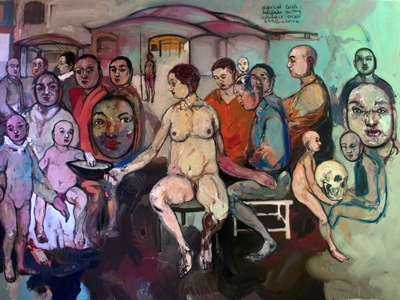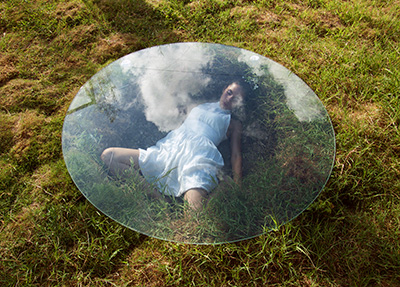A Certain Rafael Villares
By Jorge Peré
Despite being one of our most authentic young artists, the critics in our days have overlooked the work of Rafael Villares (Havana, 1989) with certain passiveness and mistrust. Perhaps that same authenticity creates a conflict among us, reporters of the emerging Cuban art, who many times choose the easy critical interpretation and leave aside, in a silent zone, those productions that distance themselves from the norm and are marked by a different complexity.
However, it seems impossible to silence the weight of a profound work in its conceptual scope, created on the basis of a careful research and articulated with unwonted visual aesthetics that cannot be condensed in a segment or definitive language. And the reason is that when Rafael Villares pretends to modify our perception of space and specifically the landscape as rational image, he ends by creating a crisis for any determinism.
It is no secret that Villares reached maturity quite early. Certain works from his first youth like Finisterre (2005) are memorable; in it he dares handle one of our most common traumas, the insularity, without treating is as commonplace. In this piece he artist appeals to photography as support, and he will return to it at other moments of his production. From his days in San Alejandro we also recall his disconcerting installations and environments, in which he definitely establishes his future obsessions and most frequent ideas: the approach of the landscape as sensorial experience, the perception of space and its relation to the subject, and the leading role of the natural and organic as source of a transcendent existence.
The intervention Aliento (Breath) (2005) was perhaps the climax of his initiation in installation art. The purpose was to reproduce a field of caña brava, with all the unsuspected sensations they produce inside an exhibition space. In addition, the artist availed himself of another resource to boost the experience: sound, not only complementing the physical space but contributing to a more detailed perception of it. It should be mentioned that the union of appearance and sound reappeared increasingly in Villares’s work, reflecting the way in which we receive and create stimuli. With that same logic he also articulated the visual essays that make up the series De soledad humana (Of Human Loneliness) (2009), with the particularly surprising installations Éxodo de un diente de león (Exodus of a Lion’s Tooth) and De soledad humana (Of Human Loneliness), based on different concepts though equally reflexive in their discourse.
Already at the Higher Institute of Art (ISA), Villares continued to display his theses on the landscape through his work. But now he will tend to do away with the enclosure that distinguished his first installation period. In this way the level of affectation and change in the spectator (pretended since his initial creations) will grow, since his now much larger pieces will establish a dialogue with the landscape and the strangest viewers.
For the Eleventh Havana Biennial (2012) the artist prepared two projects of remarkable impact because of their physical dimensions and because they predicted a turn in his visual art form. Reconciliación (Reconciliation) (2012), a piece installed in the ISA campus, consisted of two urban street lamps that called the attention because of their appearance: their upper parts were twisted at the height of the lamps, ending in a single support that rose from the ground. The suggestive detail was that one of them had been used in the USA, while the other belonged to our context.
Paisaje itinerante (Itinerant Landscape) (2012) was another of the artist’s visual essays. A kind of giant flowerpot contained a tree and a bench. On the lower part there was an access for the spectators. Villares had previously developed this concept of inhabitable work, but never like that. The flowerpot, which was exhibited in La Cabaña and two other important spots of the Havana malecón became a metaphor related to contemplation. Even though the public could enter that unusual piece, everyone preferred to observe it from outside, become fascinated with its poetic ingeniousness, and take a snapshot without damaging its formal beauty. In terms of intervention and dialogue with the urban landscape, Paisaje is a landmark among Villares’s formulations.
In recent years the artist has brought his production again to the gallery. As a matter of fact he continues to explore the same topics, i.e., the landscape and its perceptive variations, but now from a vision that adds the transcendent, the multiple coincidences that appear when searching into nature as center of life. Perhaps it is in this point that Rafael Villares most clearly and profoundly articulates his pantheism.
One of his most recent series, Morfología del eco (Morphology of the Echo) (2014 to the present), tells about a research process compiling scientific (apocryphal?) data, philosophical speculations and visual representations of an essential truth: the existence of a single spirit, of a single (divine?) force that mutates, trying to become visible in the most dissimilar earthly features. Thus, through different supports we are told about the transcendent relation that may develop between a tree and a human being, rivers and lightning, the Earth and the elements that inhabit it.
In a certain way, Rafael Villares confirms with this series his aesthetic standpoint, marked by compositional freedom and the handling of mixed solutions. He would seem to be addressing us all the time with a certain chronic romanticism from a different philosophy of art, letting us feel that imagination and poetry as resource to deal with reality and the human condition have not disappeared.



